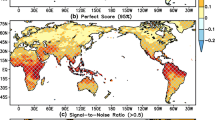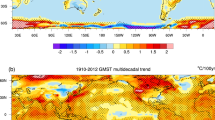Abstract
Over the mid-latitude North Pacific, there is a close relationship between interannual variations of the sea surface temperature (SST) and surface shortwave radiation during boreal summer. The present study evaluates this relationship in coupled model simulations, forced model simulations, and retrospective forecasts. It is found that the simulation of this relationship in climate models is closely related to the model biases in the meridional gradients of mean SST and surface shortwave radiation. A southward shift in the region of large mean meridional gradients leads to a similar southward shift in the region of large correlation between the SST and shortwave radiation variations. The relationship is enhanced (weakened) when the mean meridional gradients are stronger (weaker) compared to observations. The shortwave radiation–SST correlation is weak in individual forced simulations because of the interference of internally generated shortwave radiation variations. The shortwave radiation–SST correlation increases significantly in the ensemble mean due to reduction of internally generated variability. The long-lead Climate Forecast System (CFS) forecasts have a better simulation of the shortwave radiation–SST correlation compared to the short-lead forecasts. Estimation based on the CFS ensemble forecasts indicates that the high-frequency atmospheric variations contribute importantly to the SST variability over the mid-latitude North Pacific during boreal summer.









Similar content being viewed by others
References
Alexander M, Yin J, Branstator G, Capotondi A, Cassou C, Cullather R, Kwon YO, Norris J, Scott J, Wainer I (2006) Extratropical atmosphere–ocean variability in CCSM3. J Clim 19:2496–2525
Bond NA, Cronin MF (2008) Regional weather patterns during periods of anomalous air–sea interactions at the Kuroshio Extension Observatory (KEO). J Clim 21:1680–1697
Bretherton CS, Battisti DS (2000) An interpretation of the results from atmospheric general circulation models forced by the time history of the observed sea surface temperature distribution. Geophys Res Lett 27:767–770
Chang EKM, Orlanski (1993) On the dynamics of a storm track. J Atmos Sci 50:999–1015
Collins WD et al (2006) The Community Climate System Model Version 3 (CCSM3). J Clim 19:2122–2143
Delworth TL et al (2006) GFDL’s CM2 global coupled climate models. Part I. Formulation and simulation characteristics. J Clim 19:643–674
Frankignoul C, Kestenare E (2002) The surface heat flux feedback. I. Estimates from observations in the Atlantic and the North Pacific. Climate Dyn 19:633–647
Inatsu M, Mukougawa H, Xie SP (2002) Tropical and extratropical SST effects on the midlatitude storm track. J Meteorol Soc Jpn 80:1069–1076
Inatsu M, Mukougawa H, Xie SP (2003) Atmospheric response to zonal variations in midlatitude SST: transient and stationary eddies and their feedback. J Clim 16:3314–3329
Kinter III JL, DeWitt DG, Dirmeyer PA, Fennessy MJ, Kirtman BP, Marx L, Schneider EK, Shukla J, Straus D (1997) The COLA atmosphere–biosphere general circulation model, vol 1: formulation. COLA Technical Report 51, p 46
Kinter III JL, Fennessy MJ, Krishnamurthy V, Marx L (2004) An evaluation of the apparent interdecadal shift in the tropical divergent circulation in the NCEP–NCAR reanalysis. J Clim 17:349–361
Klein S, Hartmann DL (1993) The seasonal cycle of low stratiform clouds. J Clim 6:1587–1606
Mochizuki T, Awaji T (2008) Summertime evolution of decadal sea surface temperature anomalies in the midlatitude North Pacific. J Clim 21:1569–1588
Nakamura H, Sampe T, Tanimoto Y, Shimpo A (2004) Observed associations among storm tracks, jet streams and midlatitude oceanic fronts. Earth’s climate: the ocean–atmosphere interaction. Geophys Monogr, Am Geophys Union 147:329–346
Nakamura H, Sampe T, Goto A, Ohfuchi W, Xie SP (2008) On the importance of midlatitude oceanic frontal zones for the mean state and dominant variability in the tropospheric circulation. Geophys Res Lett 35:L15709. doi:10.1029/2008GL034010
Norris JR (1998) Low cloud type over the ocean from surface observations. Part II. Geographical and seasonal variations. J Clim 11:383–403
Norris JR (2000) Interannual and interdecadal variability in the storm track, cloudiness, and sea surface temperature over the summertime North Pacific. J Clim 13:422–430
Norris JR, Iacobellis SF (2005) North Pacific cloud feedbacks inferred from synoptic-scale dynamic and thermodynamic relationships. J Clim 18:4862–4878
Norris JR, Leovy CB (1994) Interannual variability in stratiform cloudiness and sea surface temperature. J Clim 7:1915–1925
Norris JR, Weaver CPP (2001) Improved techniques for evaluating GCM cloudiness applied to the NCAR CCM3. J Clim 14:2540–2550
Norris JR, Zhang Y, Wallace JM (1998) Role of low clouds in summertime atmosphere–ocean interactions over the North Pacific. J Clim 11:2482–2490
Park S, Deser C, Alexander MA (2005) Estimation of the surface heat flux response to sea surface temperature anomalies over the global oceans. J Clim 18:4582–4599
Reynolds RW, Rayner NA, Smith TM, Stokes DC, Wang W (2002) An improved in situ and satellite SST analysis for climate. J Clim 15:1609–1625
Rossow WB, Schiffer RA (1991) ISCCP cloud data products. Bull Am Meteorol Soc 71:2–20
Rossow WB, Walker AW, Beuschel DE, Roiter MD (1996) International Satellite Cloud Climatology Project (ISCCP) documentation of new cloud datasets. WMO/TD, No. 737: p 115, World Climate Research Programme, Geneva
Saha S et al (2006) The NCEP Climate Forecast System. J Clim 19:3483–3517
Sun S, Bleck R (2006) Multi-century simulations with the coupled GISS-HYCOM climate model: control experiments. Climate Dyn 26:407–428
Tanimoto Y, Xie SP, Kai K, Okajima H, Tokinaga H, Murayama T, Nonaka M, Nakamura H (2009) Observations of marine atmospheric boundary layer transitions across the summer Kuroshio extension. J Clim 22:1360–1374
Tokinaga H, Tanimoto Y, Xie SP, Sampe T, Tomita H, Ichikawa H (2009) Ocean frontal effects on the vertical development of clouds over the western North Pacific: in situ and satellite observations. J Clim 22:4241–4260
Wang W, Saha S, Pan HL, Nadiga S, White G (2005) Simulation of ENSO in the new NCEP Coupled Forecast System Model (CFS03). Mon Wea Rev 133:1574–1593
Weare BC (1994) Interrelationships between cloud properties and sea surface temperatures on seasonal and interannual time scales. J Clim 7:248–260
Wu R, Kinter III JL (2010) The atmosphere-ocean relationship in the mid-latitude North Pacific: seasonal dependence and east–west contrast. J Geophys Res 115. doi:10.1029/2009JD012579
Wu R, Kirtman BP (2005) Roles of Indian and Pacific Ocean air–sea coupling in tropical atmospheric variability. Climate Dyn 25:155–170
Wu R, Wang B (2000) Interannual variability of summer monsoon onset over the western North Pacific and the underlying processes. J Clim 13:2483–2501
Wu R, Kirtman BP, Pegion K (2006) Local air–sea relationship in observations and model simulations. J Clim 19:4914–4932
Zhang Y, Norris JR, Wallace JM (1998) Seasonality of large-scale atmosphere–ocean interaction over the North Pacific. J Clim 11:2473–2481
Zhang YC, Rossow WB, Lacis AA, Oinas V, Mishchenko MI (2004) Calculation of radiative fluxes from the surface to top of atmosphere based on ISCCP and other global data sets: refinement of the radiative transfer model and the input data. J Geophys Res 109:D19105. doi:10.1029/2003JD004457
Acknowledgments
The authors appreciate comments of Julia Manganello and three anonymous reviewers. This research was supported by grants from the NSF (ATM-0830068), NOAA (NA09OAR4310058 and NA09OAR4310186), and NASA (NNX09AN50G).
Author information
Authors and Affiliations
Corresponding author
Rights and permissions
About this article
Cite this article
Wu, R., Kinter, J.L. Shortwave radiation–SST relationship over the mid-latitude North Pacific during boreal summer in climate models. Clim Dyn 36, 2251–2264 (2011). https://doi.org/10.1007/s00382-010-0775-5
Received:
Accepted:
Published:
Issue Date:
DOI: https://doi.org/10.1007/s00382-010-0775-5




